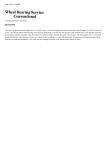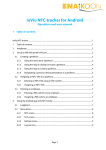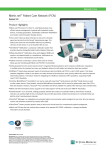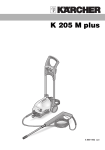Download User's Guide
Transcript
User's Guide 1995, Meridian Education Corporation Introduction This video will summarise and explain how to troubleshoot and repair automobile suspension system problems. You will learn how to detect many suspension system malfunctions by simply listening for certain abnormal noises while performing a road test on the car. Other suspension system problems can normally be diagnosed by visual inspection. This program will also show you how to perform a "shock bounce check" to determine the condition of the automobile's shock absorbers. After learning to diagnose suspension system malfunctions, this film will explain how to service shock absorbers, ball joints and bushings, struts, springs and other related components. Finally, you must always remember that a car's suspension system must be in perfect working order before releasing the car to the customer. The customer's life is literally in your hands. Student Objectives After viewing this video, the viewer will be able to: • Determine the condition of an automobile's shock absorbers. • Determine play in a car's suspension system. • Inspect the condition of an automobile's ball joints. • Detect worn control arm bushings • Inspect the condition of a ball joint's boot. • Determine the condition of an automobile's control arm. • Remove and replace a car's shock absorbers. • Remove and replace worn ball joints. • Service an automotive strut assembly. • Remove and replace the suspension springs on an automobile. To The Instructor This video is designed to be a valuable supplement to your curriculum. Since young people are extremely acclimated to television, it is a natural way to help present important aspects of your subject matter. This video is designed to give a detailed, yet broad coverage of the topic. Most educators agree that it is best to use as many instructional methods as possible. Utilise quality textbooks, workbooks, videos, lectures, demonstrations, overheads, and other methods to present the technical information. This will hold interest and help pupils understand the large amount of information required to succeed in today's complex world. This video is organised into major sections or topics. Each section covers one major segment of the subject. Graphic breaks are given between each section so that you can stop the video for class discussion, to answer critical questions, to ask questions or perform in-class demonstrations with actual components or parts. The program's format is arranged to be extremely flexible. View it full length, or use it as a supplement for lectures or demonstrations. It can also be used for self-paced individualised instruction. This video allows you to watch only a portion of the program each day or to present the complete video, depending on your curriculum requirements. The program is designed to simplify the complex. Concise wording and carefully selected graphics are used to provide maximum learning in minimum time. Close-up shots of components and service procedures are used to make every second of viewing instructional, as if each student was standing right behind you, watching over your shoulder while you were working or giving a demonstration. Our technical visual images are designed to match the audio so that every scene has maximum educational value. Computer animation is used to explain difficult to comprehend principles or techniques. Students seem to enjoy the cartoon type images that show how parts work, how they fit together, or how they vary in design. Quiz Answer Key 1. b 2. c 3. a 4. d 5. c 6. c 7. d 8. b 9. a 10. d 11. d 12. c 13. b 14. b 15. c Use your own judgement to evaluate the definitions, definition type questions, and discussion topics. Technical Terms Write definitions for the following terms. Use a textbook or review the video if needed. automotive suspension system, shock absorbers, ball joints, shock bounce check, suspension system play, jack stands, electronically controlled suspension system, suspension system springs, strut assembly, lower control arm, upper control arm, control arm bushings, pry bar, rivets, sway bar, air hammer, steering knuckle, fork tool, torque wrench, grease fitting, strut bushings, strut cartridge, chassis height values, solid-type axle, floor jack, strut- type spring compressor Video Discussion Topics Here are a few topics that might be used for a class discussion. 1. Describe how to detect play in an automobile suspension system. 2. How can worn ball joints affect suspension system performance? 3. What is the function of a suspension system sway bar? 4. Describe the basic purpose of a suspension system control arm. 5. Explain how to detect worn ball joints. 6. How can a "road test" be used to detect suspension system malfunctions? 7. Name the basic parts of an automotive shock absorber. 8. List some of the safety rules that should be followed when servicing an automotive suspension system. Video Quiz Choose the appropriate letter to indicate the most correct answer after reading the statement: 1. Tire edge wear might indicate a worn _________ or bad control arm bushing. a. strut rod b. ball joint c. strut retainer d. drive axle 2. A(n) ___________ can quickly locate __________ strut malfunctions in today's electronically controlled suspension systems. a. probe, strut malfunctions b. ohmmeter, bearing malfunctions c. scanner, trouble codes d. monitor, excessive wear 3. To verify play in the suspension system when the spring is located on the lower control arm of a modified strut, you must place the jack stand under the _____________. a. control arm b. strut rod c. joint bushing d. strut bearing 4. A ball joint ___________ is a small flange located around the grease fitting. a. end seal b. piston seal c. mounting stud d. wear indicator 5. Worn sway bar __________ will make the car more unstable when turning. a. springs b. boots c. bushings d. dampers 6. Worn control arm bushings are very common and may lead to play in the ____________. a. strut damper b. shock piston c. suspension system d. strut spring 7. Which of the following faulty suspension system components can lead to loss of vehicle control? a. worn ball joints b. worn sway bar bushings c. faulty lower control arm d. all of the above. Video Quiz (Continued) 8. ___________ replacement is the most common suspension system service operation. a, Steering knuckle b. Shock absorber c. Control arm d. None of the above 9. Servicing a ____________ generally involves ball joint and bushing replacement. a. control arm b. sway bar c. strut assembly d. coil spring 10. To remove a worn ball joint, you must either remove the bolts or cut off the rivets securing the joint to the ________. a. steering knuckle b. sway bar c. shock absorber d. control arm 11. A __________ is normally used to hold the steering knuckle onto the ball joint. a. snap ring b. cap screw c. plow bolt d. castle nut 12. A ____________, when driven between parts, produces a powerful wedging action that will separate parts without damage. a. combination wrench b. breaker bar c. fork tool d. flat chisel 13. Two large ___________ are often used to secure the ____________ to the vehicle. a. clips, steering knuckle b. breaker bar c. fork tool d. flat chisel 14. A faulty ________ will show up as a looseness or play when you bounce the car. a. upper steering knuckle b. upper strut bushing c. lower spindle bearing d. ball joint boot 15. When inspecting the condition of automotive suspension springs, you should look up the _________ values and measurement locations in a service manual. a. shock height b. strut assembly c. chassis height d. none of the above Short Answer 1. How should you begin suspension system troubleshooting? 2. Describe some of the indications of suspension system problems. 3. Explain how to perform a "shock bounce check." 4. Describe the basic purpose of suspension system ball joints. 5. What tools are normally used to remove a ball joint? 6. Describe the primary function of an automotive shock absorber. 7. List some of the indications of a faulty shock absorber. 8. Describe how to remove and replace a strut assembly. 9. Explain how to remove and replace a strut assembly. 10. Why should you always check wheel alignment after completing major suspension system repairs? We Need Your Help! We are constantly trying to improve our videos. If you have any suggestions or comments, please send them to us with details (title, time code location, etc.) of any potential improvement. We will try to incorporate suggestions when revising our videos. Your help will be greatly appreciated. We want to help you train America's youth! Other titles available from Meridian Education Corporation • • • • • • • • • • Suspension Systems (Item No.5174) Suspension System Service (Item No.5175) Steering Systems (Item No.5176) Steering System Service (Item No.5189) Brake Systems (Item No.5177) Brake System Service (Item No.5182) Wheel Bearing Service: Conventional (Item No. 5133) Wheel Bearing Service: Front-Wheel Drive (Item No.5132) Wheel Alignment Theory & Adjustment (Item No.5164) CV Axle Service (Item No.5178)

















